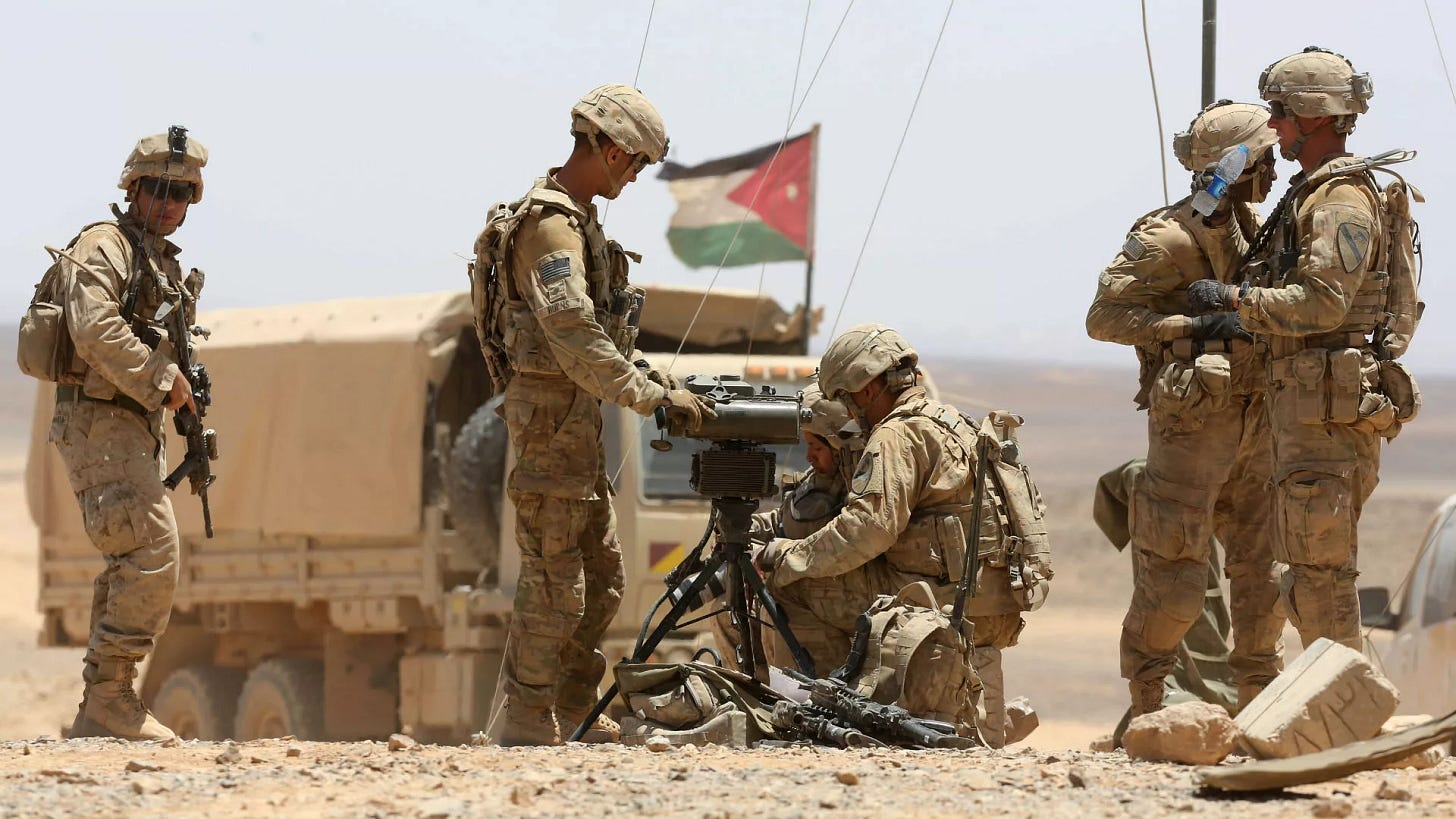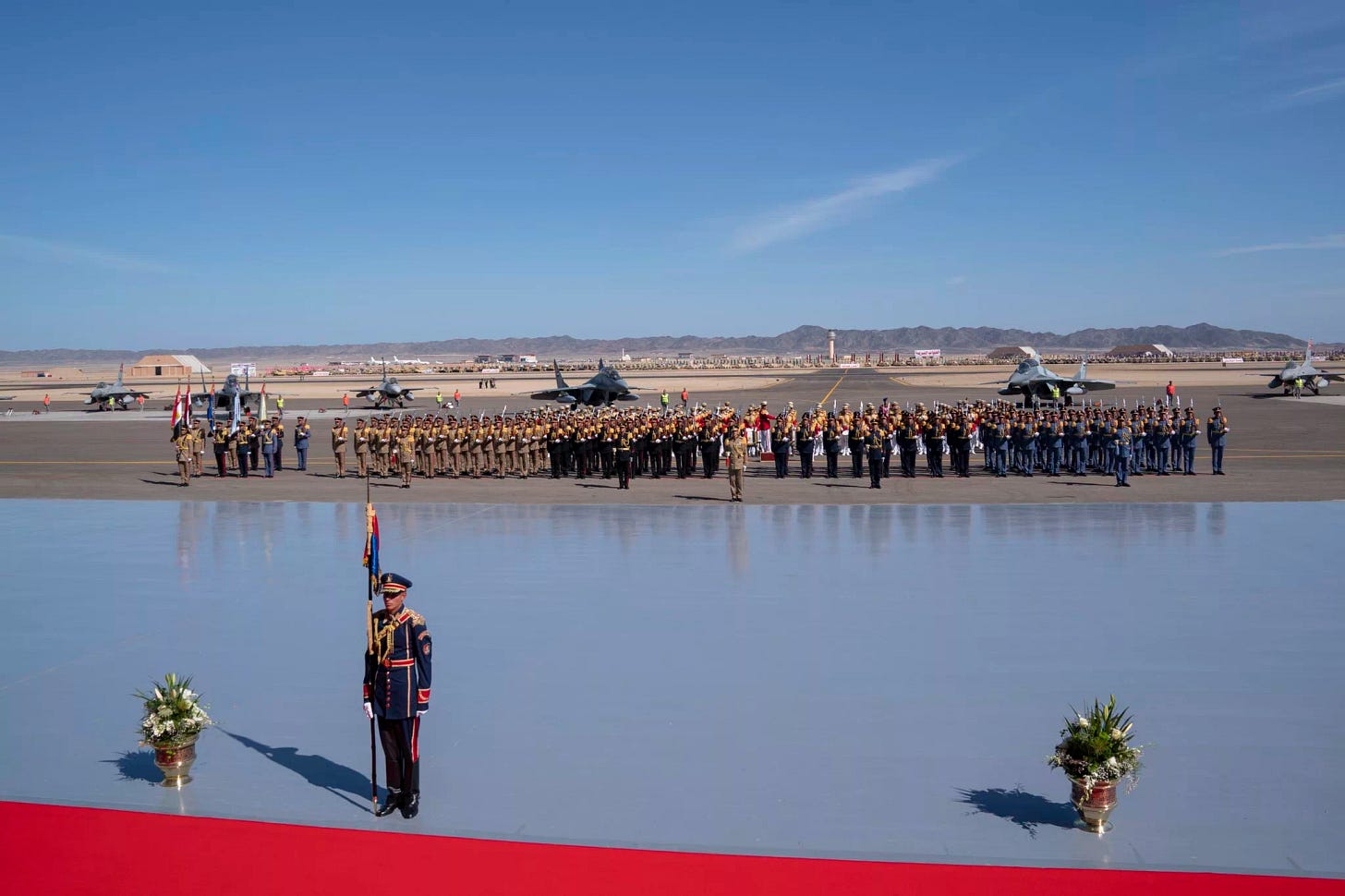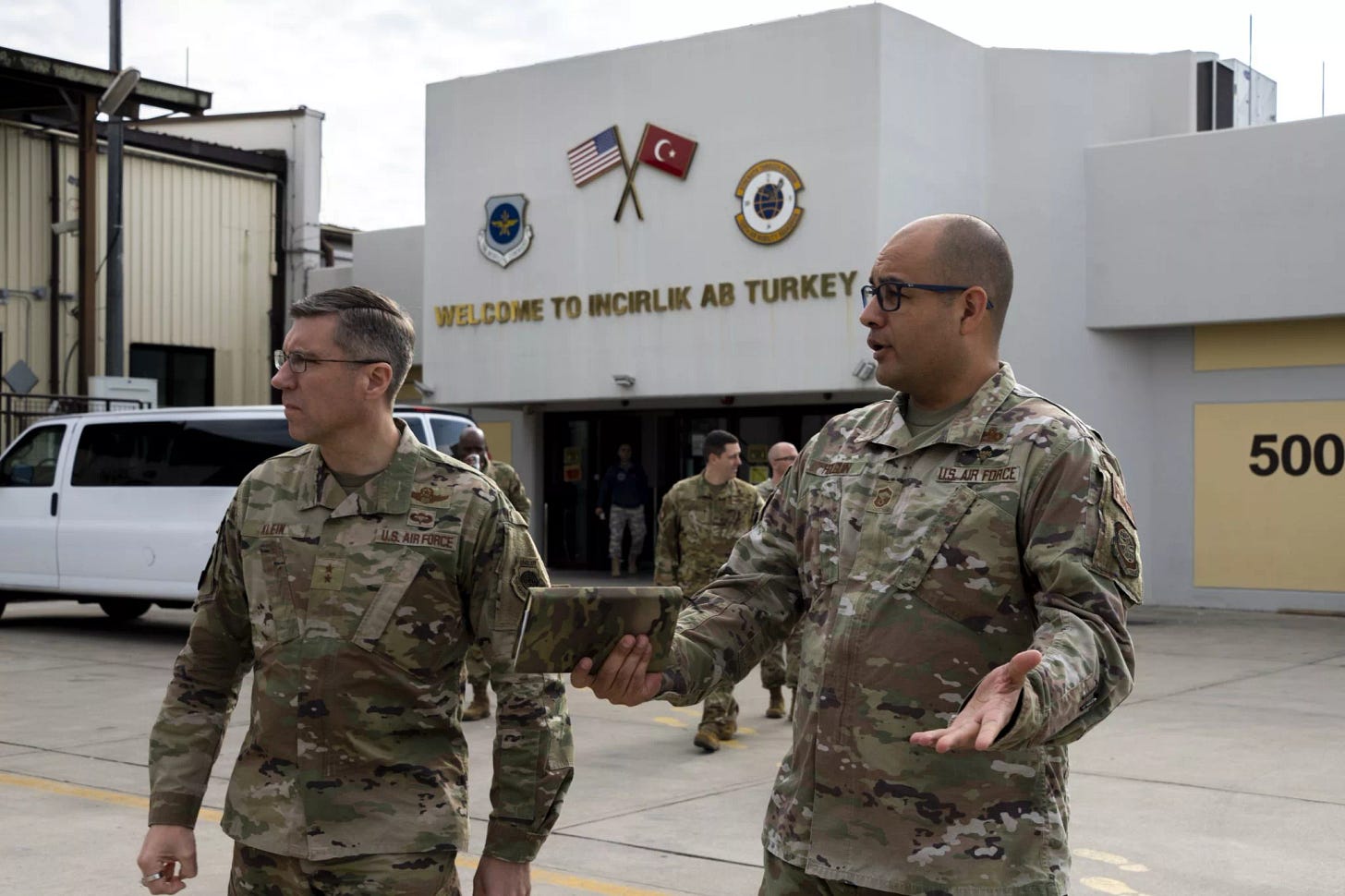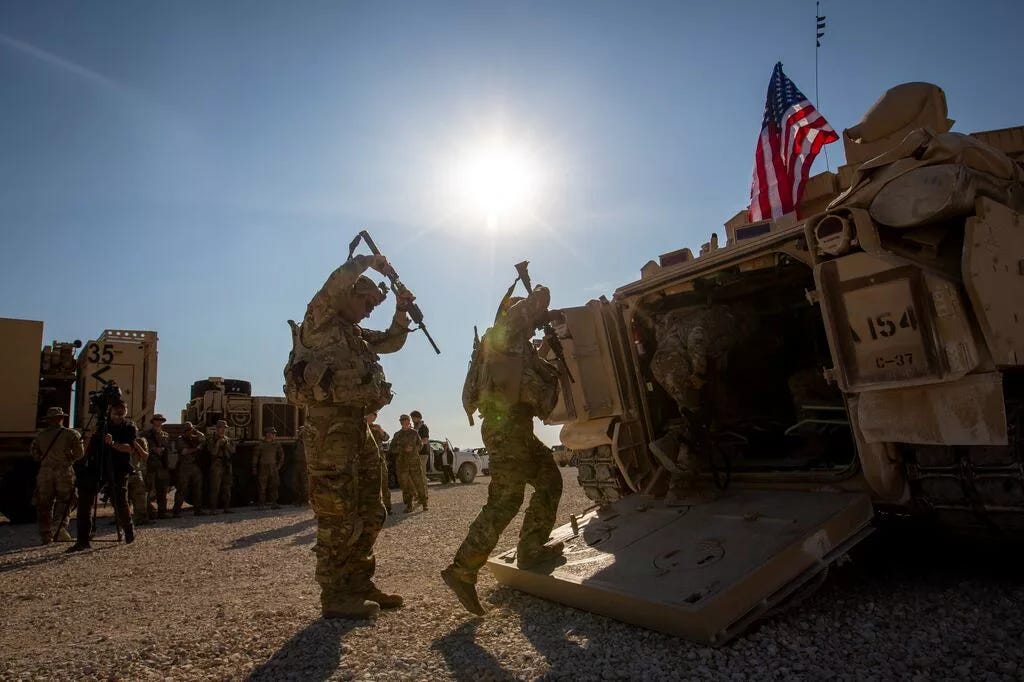Every so often, the presence of U.S. military bases in the Middle East—or West Asia—reclaims the spotlight in media and political discourse. Whether through military maneuvers, security alliances, visits by American leaders and generals, or joint exercises involving multiple nations, these discussions underscore a common denominator: the conspicuous and entrenched U.S. military presence across the region.
In 2025, notable developments have included the movement of U.S. military assets between the Indian Ocean and the Arabian Gulf, the deployment of strategic bombers, and heightened combat readiness aimed at deterring Iran and countering Houthi attacks. Simultaneously, discussions have emerged about a potential drawdown of U.S. forces in Syria and the future of American military presence in Iraq post-2026.
These scenarios position U.S. military bases as pivotal elements shaping the present and redrawing future influence maps—akin to a cocked rifle aimed at the region's peoples, awaiting only a fleeting decision to discharge.
This article delves into the origins of the U.S. military footprint in the Middle East, examining the spread of its bases in terms of equipment, scale, cost, and roles. It traces the evolution, motivations, potential outcomes, and risks posed to regional security and sovereignty.
An American Foothold in the Middle East
The U.S. military's presence in the Middle East surged post-World War II, as America extended its military gaze beyond its borders to counter Nazism and its allies in the Middle East and the Far East.
In 1945, President Franklin D. Roosevelt and Saudi Arabia's founding King Abdulaziz Al Saud signed the "Quincy Pact," wherein Washington provided security guarantees to the kingdom in exchange for access to reasonably priced oil supplies.
Over the subsequent two decades, as British and French colonial powers receded and post-colonial coups swept through much of the Arab world, the U.S. seized the opportunity to expand its influence, filling the emerging security vacuum and laying the groundwork for a sustained military presence.
By 1983, the U.S. Department of Defense established the U.S. Central Command (CENTCOM) to oversee military operations in the Middle East and South and Central Asia. Today, CENTCOM's area of responsibility encompasses 21 countries, including Saudi Arabia, Qatar, Bahrain, Kuwait, the United Arab Emirates, Oman, Iraq, Jordan, Lebanon, Egypt, and Yemen.
Since then, CENTCOM has been responsible for planning, executing, and supervising all U.S. military operations in the region, encompassing air, land, and naval bases, training camps, joint military exercises, logistical support agreements, and regional missions under the banner of "counterterrorism."
Despite the varied forms of U.S. military presence in the Arab world and the Middle East, CENTCOM's directly affiliated bases are concentrated in a select number of strategically chosen Arab countries. These locations serve Washington's military objectives and geopolitical influence in the Arab world, ensuring the security of "oil and energy routes" and bolstering allied regional regimes.
This strategic deployment has enabled the U.S. military to conduct rapid interventions and facilitate flexible movement of troops and equipment during pivotal events, including the 1991 Gulf War, the 2001 invasion of Afghanistan, the 2003 invasion of Iraq, operations against ISIS in Iraq and Syria since 2014, and managing tensions with Iran since 2017. Notably, since 2021, Israel has been incorporated into CENTCOM's area of operations, having previously fallen under the European Command (EUCOM).
Currently, an estimated 30,000 to 40,000 U.S. troops are stationed within CENTCOM's operational zones, spread across countries such as Turkey, Syria, Iraq, Jordan, Israel, Kuwait, Bahrain, Qatar, Saudi Arabia, the UAE, Oman, and Egypt.
Qatar
The U.S. military presence in Qatar dates back to 1992, following a bilateral defense agreement that allowed Washington to deploy troops and store military equipment on Qatari soil. Based on this agreement, Al Udeid Air Base was established in 1996 at an estimated cost of $1 billion. It was followed by the opening of Camp As Sayliyah in 2000, which housed vast prepositioned weapons and equipment stockpiles under what was known as Prepositioning Sites.
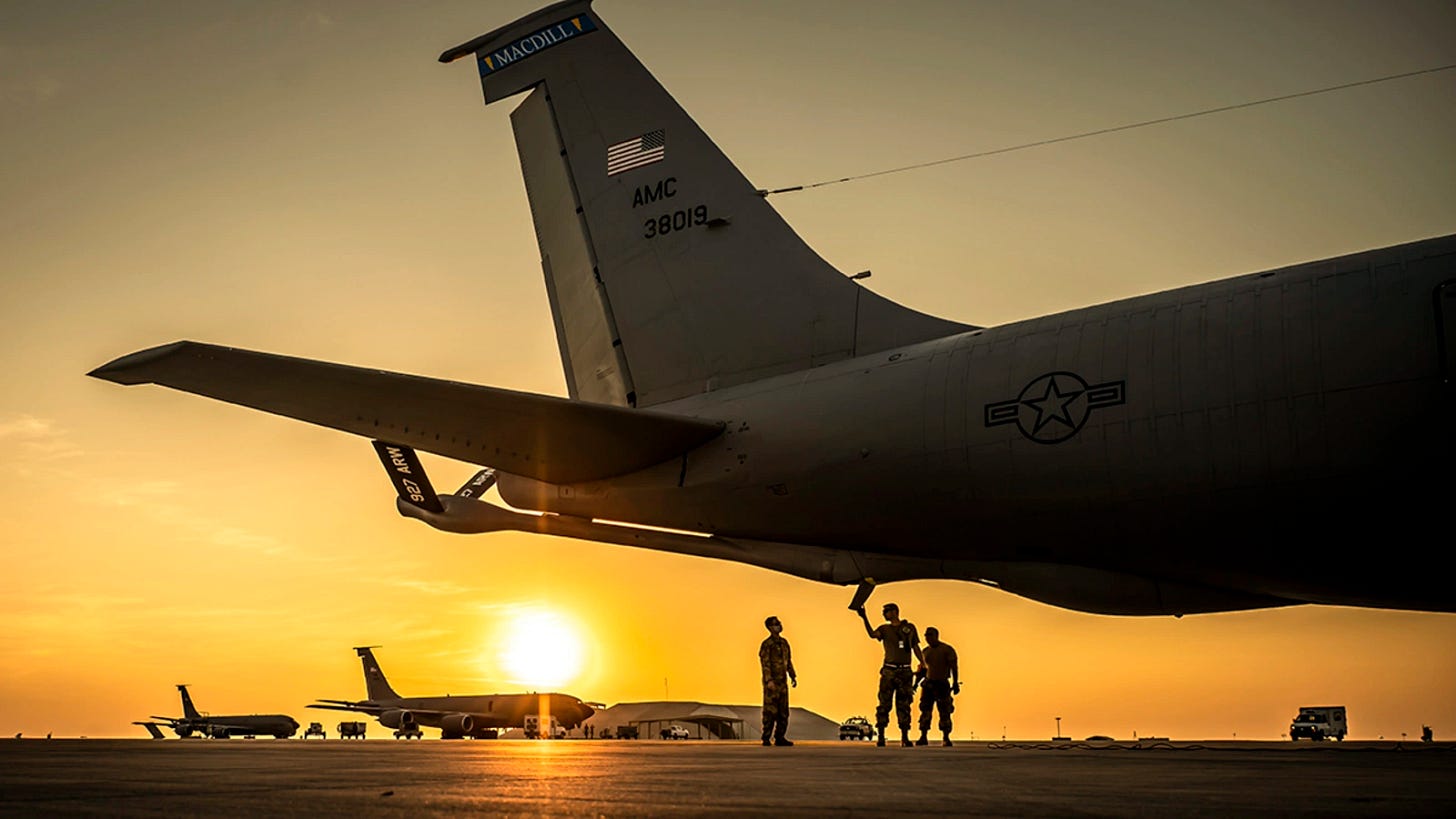
A turning point came in 2002, when CENTCOM moved its operational headquarters from Saudi Arabia to Qatar in response to Saudi pressure to reduce the visibility of U.S. forces within its borders. This transition led to an expanded American military footprint in Qatar, making it the largest U.S. base presence in the Middle East.
Today, the number of U.S. troops in Qatar is estimated between 11,000 and 13,000, most of whom are stationed at Al Udeid. Camp As Sayliyah was closed in 2021, with its equipment relocated to Jordan.
Al Udeid serves several strategic functions: it is the hub of U.S. air operations in the Middle East and Central Asia, hosts the forward headquarters of CENTCOM, and includes the Combined Air Operations Center (CAOC), which coordinates daily flight missions involving more than 18 allied nations. The base has some of the longest runways in the Gulf, capable of accommodating large aircraft such as the B-52 and C-17. It is also a key station for the UK’s Royal Air Force and other U.S.-led coalition partners.
Bahrain
Bahrain was one of the earliest Arab countries to host U.S. military forces, even before gaining independence from Britain. During World War II, British forces, in need of American support, allowed a detachment known as the U.S. Middle East Force to be stationed at the Juffair naval base in 1948.
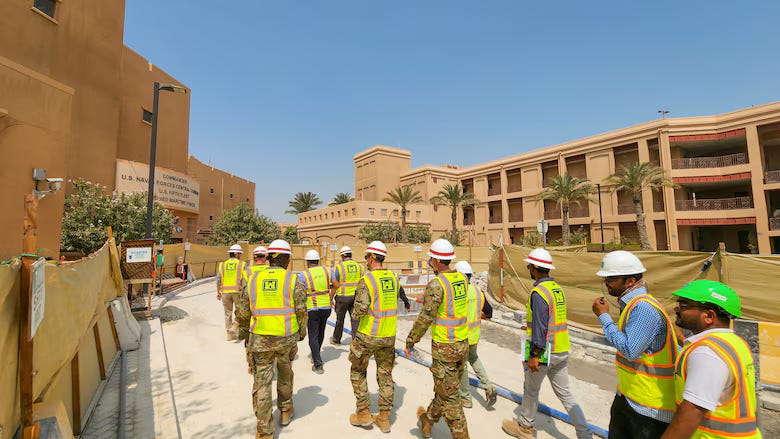
Following Bahrain’s independence in 1971, the U.S. Navy quickly assumed responsibilities formerly held by British forces—an arrangement sanctioned by Emir Hamad bin Isa Al Khalifa. Subsequent bilateral security cooperation agreements in 1971 and again in 1991 led to the creation of additional air bases, including Sheikh Isa Air Base and Al Muharraq Air Base, the latter part of Bahrain International Airport.
With the 2003 Iraq invasion and growing regional deployments, U.S. military infrastructure in Bahrain expanded significantly to accommodate over 9,000 American troops. In 2021, the U.S. Department of Defense awarded the National Security Agency in Bahrain a citation for excellence, recognizing its management of U.S. military installations in the country.
Bahrain remains a critical maritime hub for the U.S. Fifth Fleet, which oversees naval operations across the Gulf, Red Sea, and Arabian Sea—contributing significantly to the projection of U.S. naval power across the broader region.
Kuwait
The U.S. military presence in Kuwait began after the 1991 Gulf War, when the United States led a coalition to expel Iraqi forces from the country. What followed was a long-term defense agreement that enabled the U.S. to maintain a military foothold in Kuwait through base construction, joint exercises, and strategic equipment storage.
This presence expanded dramatically in 2003 during the U.S. invasion of Iraq, with Kuwait serving as the primary launchpad for American operations. It later supported missions against ISIS in Iraq and Syria. Despite a gradual drawdown in neighboring Iraq, the U.S. military remains a major presence in Kuwait.
As of 2021, there were approximately 13,000 U.S. troops stationed in Kuwait, spread across various commands including the Joint Task Force, the 386th Air Expeditionary Wing, the 3rd Infantry Division, and coalition support elements. These forces are deployed across key bases such as Camp Arifjan (the main hub for American operations in Kuwait), Ali Al Salem Air Base, Camp Doha, and Camp Buehring.
Iraq
Following the U.S. occupation of Iraq, the country became heavily militarized, with over 500 American military sites established in the early years. These ranged from administrative centers and political command hubs to training bases, logistics facilities, aircraft maintenance depots, and major runways. By the end of 2011, the U.S. announced a formal withdrawal of troops, leaving behind only a few unofficial bases.
This withdrawal, however, was short-lived. In 2014, under the pretext of fighting ISIS, U.S. forces returned and reinforced their presence at seven major bases. Though later reduced, the current troop count in Iraq stands at approximately 2,500.
These forces are deployed under security agreements with the Iraqi government and are primarily stationed at Ain al-Asad Air Base in Anbar province and Erbil Air Base in the Kurdistan Region, along with other dispersed sites. Additionally, American officers and trainers are embedded within the U.S. Embassy in Baghdad.
Saudi Arabia
Prior to the 1991 Gulf War, U.S. military presence in Saudi Arabia was limited to joint training, arms deals, and the occasional use of facilities like Dhahran Air Base. However, once the war broke out, Saudi Arabia opened its territory to U.S. forces. More than 500,000 American troops were deployed to the Eastern Province and areas bordering Kuwait, where they established major operational bases.
After the war, the U.S. maintained a continuous presence under various pretexts, including enforcing the no-fly zone over southern Iraq, monitoring Iraqi airspace, and protecting oil infrastructure in the Gulf.
Key bases during this period included Prince Sultan Air Base—then the air operations command hub for CENTCOM—as well as Dhahran Air Base (King Abdulaziz Air Base) and Riyadh Air Base. Between 5,000 and 10,000 troops were typically stationed there until 2003.
In 2003, the U.S. officially ended its military presence in Saudi Arabia and relocated the air command center to Qatar, shutting down Prince Sultan Air Base. However, circumstances changed again in mid-2019 when the U.S. Department of Defense announced the temporary deployment of approximately 3,000 troops, along with F-15 and F-22 aircraft and air defense systems, in response to escalating tensions with Iran. This move partially reactivated Prince Sultan Air Base as a center for operations, reconnaissance, and air defense.
Today, an estimated 2,500 to 3,000 U.S. troops are stationed in Saudi Arabia, most of them at Prince Sultan. Others are spread across temporary air defense outposts, such as Eskan Village and areas near oil facilities. Despite this, Saudi Arabia is still not classified as a permanent major U.S. base like Qatar or Kuwait.
United Arab Emirates
The United Arab Emirates is one of the countries where the U.S. maintains a flexible military presence. Unlike Bahrain, Qatar, and Kuwait, where the U.S. has dedicated and expansive military bases, American troops in the UAE—estimated at around 3,500—are primarily stationed at joint-use facilities operated by the Emirati military.
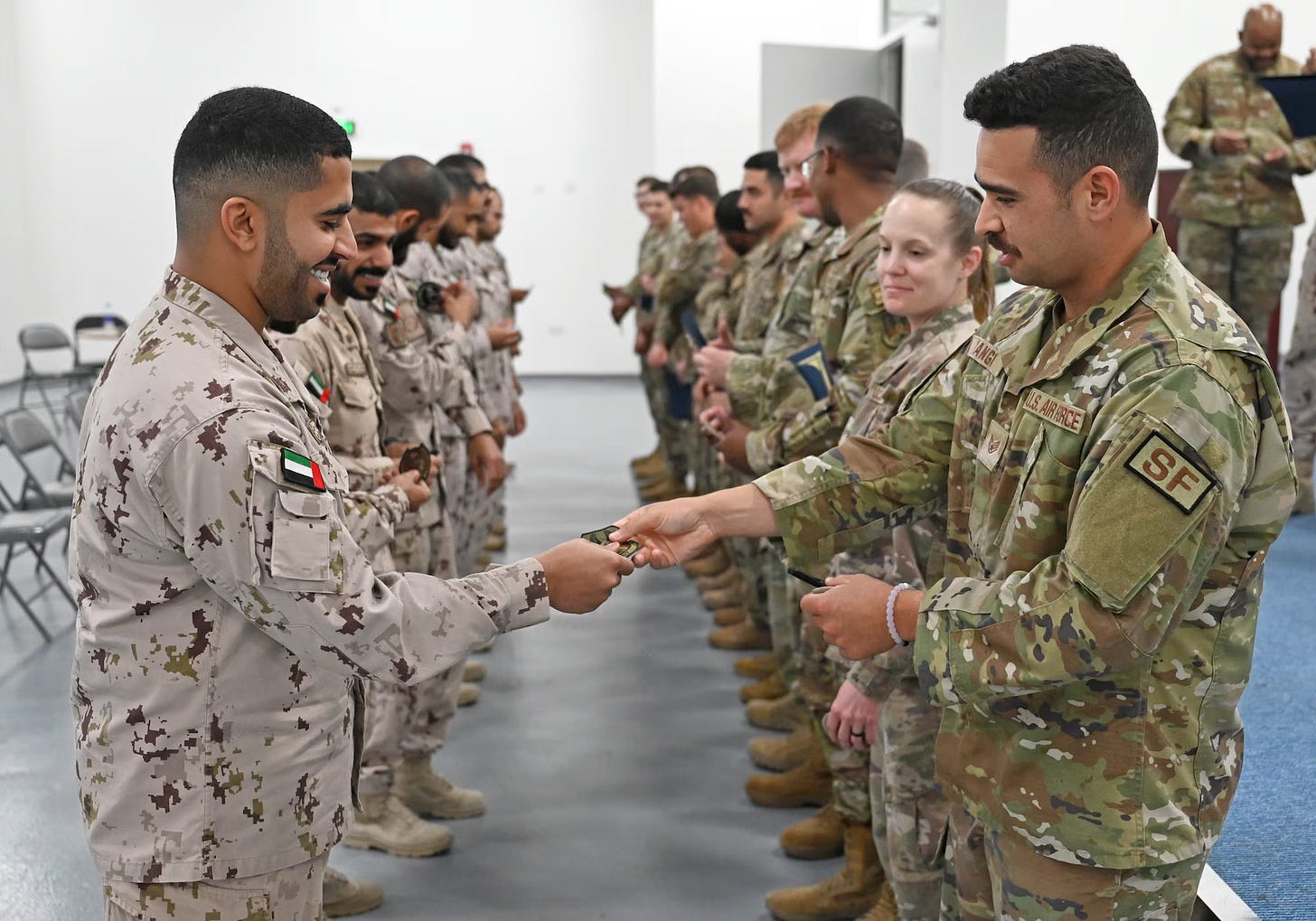
This arrangement stems from a series of defense agreements signed between 1994 and 2017, granting U.S. forces immediate access to Emirati infrastructure when needed, while also facilitating joint training and regional military exercises.
The most significant of these sites is Al Dhafra Air Base in Abu Dhabi, used by approximately 2,000 to 2,500 U.S. troops. This base also hosts French forces and supports U.S. air operations across Iraq, Syria, and the Gulf. It plays a key role in maintaining regional air superiority and enabling rapid deployment.
Additionally, Jebel Ali Port in Dubai, while not a U.S. base, serves as a critical resupply and maintenance hub for the U.S. Navy. It is used frequently for ship repairs, refueling, and provisioning. Jebel Ali’s logistical role is further connected to Fujairah Naval Base, offering an overland fallback route should the Strait of Hormuz be closed.
Oman
Oman shares a similar model of U.S. military presence with the UAE, based on access agreements that allow American forces to utilize Omani facilities when needed. This partnership began with a 1980 agreement, which was updated in 1990 and significantly expanded in 2019.
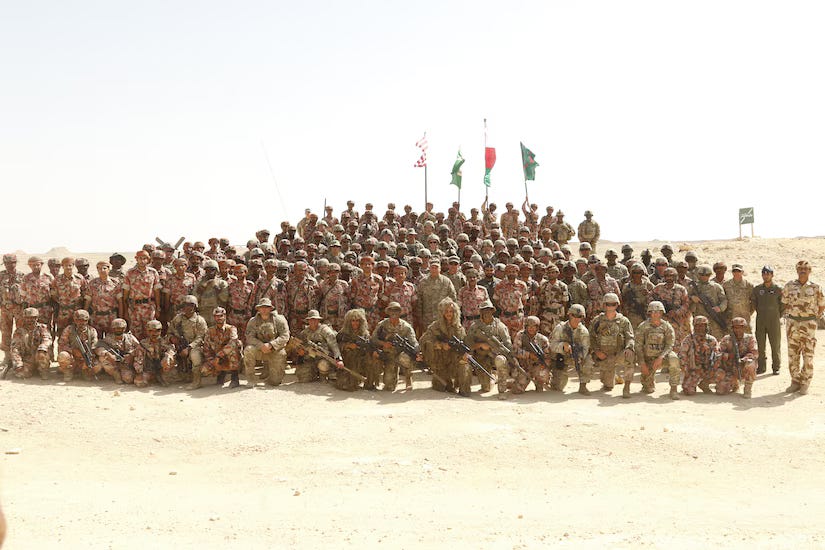
Under these arrangements, the U.S. military can access key sites such as Masirah Air Base, which has served as a critical refueling and logistical support station during the Gulf War and the war in Afghanistan. Thumrait Air Base has also hosted U.S. forces during operations in Afghanistan and Iraq.
Other notable sites include Duqm Port and Al Seeb Air Base, all of which are available for joint exercises, prepositioning of equipment, and logistical support. These facilities are used intermittently but are vital for enabling regional flexibility and rapid deployment.
Jordan
After the 1991 Gulf War, Jordan began receiving substantial U.S. military assistance and became a regular participant in joint military exercises with the United States. By 2003, Jordan had become a key logistical corridor for U.S. forces heading into Iraq, prompting the establishment of temporary facilities near the border.
With the rise of ISIS in 2014, Jordan was transformed into a frontline state for the U.S.-led coalition. The bilateral defense cooperation agreement signed in 2021 further entrenched this presence, granting U.S. forces freedom of movement and access to 12 military installations across the kingdom. The agreement also granted American personnel legal immunity from Jordanian jurisdiction.
As a result, a permanent U.S. deployment took shape at Muwaffaq Salti Air Base, which was significantly expanded in 2019 with $143 million in U.S. funding. The base serves as a launch site for operations in Syria and Iraq. Another key outpost is Tower 22 near the Syrian border, which came under drone attack in January 2024, killing three American troops.
Additional facilities include training and storage centers, most notably the King Abdullah II Special Operations Training Center, which was built and funded with U.S. oversight and is used to train both Jordanian and partner forces.
By mid-2024, the number of U.S. troops in Jordan reached 3,813—the highest since the 2003 Iraq invasion—marking a 20% increase over figures from December 2023. The buildup aims to enhance air defenses, expand joint training, and deter regional threats, while securing American and allied interests in the area.
Egypt
The U.S. military presence in Egypt is one of the oldest examples of American defense cooperation in the region, though it is notably different from other cases due to the absence of permanent bases or routine deployments.
The partnership is rooted in a long-standing bilateral agreement, most notably the Camp David Accords of 1979, which paved the way for annual U.S. military aid to Egypt—amounting to $1.3 billion to this day.
In the decades that followed, this cooperation expanded to include joint exercises, such as the biennial “Bright Star” drills, security consultations, and military-to-military exchanges coordinated through the U.S. Embassy’s Office of Military Cooperation.
A small contingent of U.S. troops—roughly 400 to 500—serves in the Multinational Force and Observers (MFO) stationed at El Gorah in North Sinai. This force, primarily responsible for monitoring the Egypt-Israel peace treaty, is the largest American component in the country.
Numbers occasionally increase during large-scale exercises like Bright Star, particularly at the Mohamed Naguib Military Base near El Alamein.
Additionally, bilateral agreements allow the U.S. to use Egyptian airspace and ports in times of emergency or for logistical operations. American military roles in Egypt include peace treaty monitoring, counterterrorism support—especially in Sinai—and oversight of military aid programs and technology transfers.
Turkey
Since joining NATO in 1952, Turkey has been a strategic platform for U.S. military operations during and after the Cold War. Its geographic location made it a frontline state for monitoring the Soviet Union and later, projecting power into the Middle East.
Over the decades, the U.S. has operated several military installations in Turkey, most prominently Incirlik Air Base, which has been active since the 1950s. Incirlik has supported logistical and intelligence operations and is widely believed to house approximately 50 tactical nuclear weapons, although this has never been officially confirmed.
Another key site is Kürecik Radar Station, where an advanced radar system is deployed as part of the European Phased Adaptive Approach to missile defense, aimed primarily at detecting and intercepting potential threats from Iran.
U.S. military assets are also present in joint facilities across Ankara, Istanbul, and Izmir, supporting both NATO operations and U.S. missions in the region. Troop levels in Turkey fluctuate but are generally estimated between 1,700 and 2,500, with most based at Incirlik.
These installations enable air superiority, surveillance, and rapid deployment capabilities that are critical to U.S. and NATO strategy across the Middle East.
Syria
Syria represents one of the starkest examples of unauthorized U.S. military presence in the region. Since 2014, the U.S. has maintained troops on Syrian territory without the formal consent of the Syrian government, initially under the pretext of combating ISIS.
What began as a campaign of airstrikes quickly evolved into boots on the ground, with U.S. special operations forces and intelligence personnel deployed to support the Syrian Democratic Forces (SDF). Between 2016 and 2017, the U.S. established temporary bases and small airfields across northeastern Syria, primarily in areas under SDF control—including Hasakah, Raqqa, and Deir ez-Zor.
The footprint later expanded to include locations such as Kobani (Ayn al-Arab), Tal Abyad, Manbij, Rmelan, al-Shaddadi, and al-Tanf, near the strategic tri-border area with Iraq and Jordan. By the end of 2018, roughly 2,000 U.S. troops were in Syria, including Marines, special forces, and logistics units.
Strategic positioning was central: Rmelan sits near major oil fields; Deir ez-Zor borders the al-Omar oil field; and al-Tanf anchors U.S. oversight at a key regional juncture. Throughout successive U.S. administrations—Trump, Trump’s second term, and now Biden—the number of troops has fluctuated, at times dropping to 900 before climbing again to 2,000 near the end of Biden’s term.
In April 2024, the Pentagon announced plans to reduce troops to under 1,000 and shutter three smaller bases in northeastern Syria. However, analysts see this more as a tactical repositioning than a full withdrawal. Many believe the U.S. aims to maintain a low-cost security footprint while awaiting political shifts in Damascus that could favor American interests.
Lebanon
There are no permanent U.S. military bases in Lebanon, but the relationship between the Lebanese military establishment and the United States is among the closest in the region. Since 2006, the U.S. Department of Defense has been the largest single provider of military assistance to Lebanon, contributing over $3 billion in aid.
This support takes the form of armored vehicles, ammunition, personal weapons, surveillance technology, communication systems, and light aircraft for reconnaissance. A major pillar of the relationship is training, highlighted by regular joint exercises such as the “Rising Thunder” drills involving U.S. Marines on Lebanese soil.
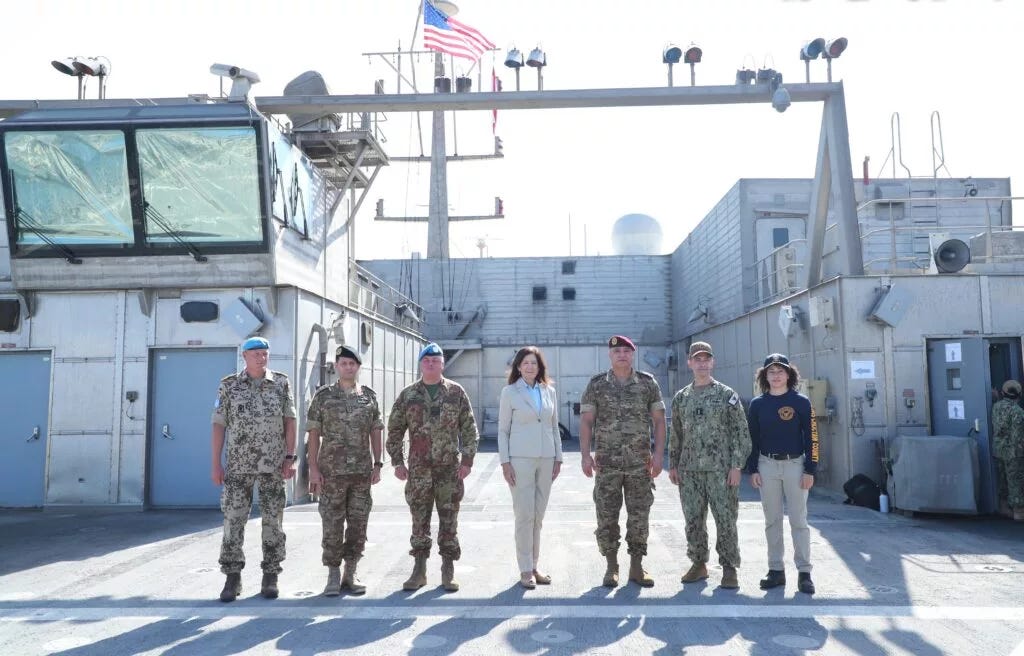
While the U.S. does not operate its own military facilities in Lebanon, it occasionally uses ports and airports for limited operations, or stations ships off the Lebanese coast for logistical purposes. These activities are coordinated directly with the Lebanese government and the Lebanese Armed Forces.
A key moment highlighting this alignment came in October 2023, when the U.S. deployed the aircraft carrier USS Gerald R. Ford to the eastern Mediterranean. Positioned off the Lebanese coast, the move was intended to deter Hezbollah amid rising tensions on Israel’s northern border.
Ultimately, the widespread U.S. military deployment across the Middle East—augmented by Israeli and European elements serving similar geopolitical interests—shows no signs of receding anytime soon. On the contrary, it supports ongoing efforts to reshape the region into a normalized bloc centered around Israel.
The region remains governed by client regimes and populations subdued beneath the shadow of foreign dominance. Whether the coming years will bring another colonial chapter or the long-awaited dawn of freedom remains an open question.






